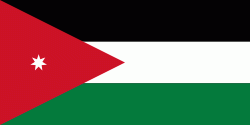Umm el-Jimal (Umm al Jimāl)
Umm el-Jimal (ام الجمال, "Mother of Camels"), also known as Umm ej Jemāl, Umm al-Jimal or Umm idj-Djimal, is a village in Northern Jordan approximately 17 kilometers east of Mafraq. It is primarily notable for the substantial ruins of a Byzantine and early Islamic town which are clearly visible above the ground, as well as an older Roman village (locally referred to as al-Herri) located to the southwest of the Byzantine ruins.
Umm el-Jimal is a large village located in northern Jordan less than 10 km from the Syrian border. It is located in the Hauran, the northern desert region of the country. Despite this aridity, Umm el-Jimal is surprisingly well suited for agriculture, and its livelihood and economy is largely derived from agricultural and pastoral sustenance. The ruins of an ancient village lie in the midst of modern Umm el-Jimal. The ruins date from the Nabataean through the Abbasid periods. The earthquake of circa AD 749 did major damage, but the community survived well into the Abbasid period. In the early twentieth century the area was repopulated by the Druze and then the Bedouin Msa'eid tribe.
Umm el-Jimal is a large village located in northern Jordan less than 10 km from the Syrian border. It is located in the Hauran, the northern desert region of the country. Despite this aridity, Umm el-Jimal is surprisingly well suited for agriculture, and its livelihood and economy is largely derived from agricultural and pastoral sustenance. The ruins of an ancient village lie in the midst of modern Umm el-Jimal. The ruins date from the Nabataean through the Abbasid periods. The earthquake of circa AD 749 did major damage, but the community survived well into the Abbasid period. In the early twentieth century the area was repopulated by the Druze and then the Bedouin Msa'eid tribe.
Map - Umm el-Jimal (Umm al Jimāl)
Map
Country - Jordan
 |
 |
| Flag of Jordan | |
Modern-day Jordan has been inhabited by humans since the Paleolithic period. Three stable kingdoms emerged there at the end of the Bronze Age: Ammon, Moab and Edom. In the third century BC, the Arab Nabataeans established their Kingdom with Petra as the capital. Later rulers of the Transjordan region include the Assyrian, Babylonian, Roman, Byzantine, Rashidun, Umayyad, Abbasid, and the Ottoman empires. After the Great Arab Revolt against the Ottomans in 1916 during World War I, the Greater Syria region was partitioned by Britain and France. The Emirate of Transjordan was established in 1921 by the Hashemite, then Emir, Abdullah I, and the emirate became a British protectorate. In 1946, Jordan gained independence and became officially known in Arabic as the Hashemite Kingdom of Jordan. The country captured the West Bank during the 1948 Arab–Israeli War and annexed it until it was lost to Israel in 1967. Jordan renounced its claim to the territory in 1988, and became the second Arab state to sign a peace treaty with Israel in 1994.
Currency / Language
| ISO | Currency | Symbol | Significant figures |
|---|---|---|---|
| JOD | Jordanian dinar | دا | 3 |
| ISO | Language |
|---|---|
| AR | Arabic language |
| EN | English language |















